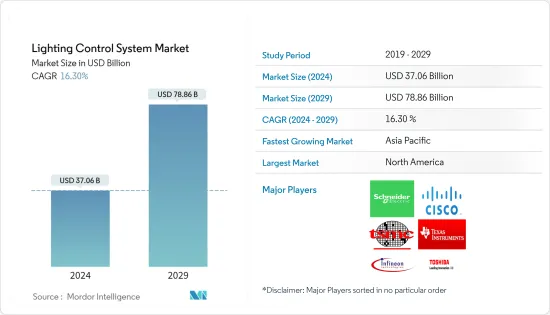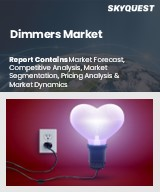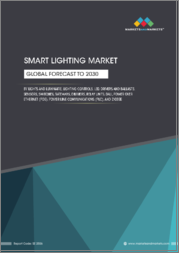
|
시장보고서
상품코드
1433771
세계 조명 제어 시스템 : 시장 점유율 분석, 산업 동향,통계, 성장 예측(2024-2029년)Lighting Control System - Market Share Analysis, Industry Trends & Statistics, Growth Forecasts (2024 - 2029) |
||||||
조명제어시스템 시장 규모는 2024년 370억 6,000만 달러로 추정되고, 2029년까지 788억 6,000만 달러에 이를 것으로 예측되며, 예측기간(2024년-2029년) 동안 복합 연간 성장률(CAGR) 16.30%를 나타낼 전망입니다.

시장은 스마트폰이나 태블릿 등 스마트 기기의 사용이 증가하고 있으며 사물인터넷(IoT)의 도입을 향해 진행되고 있습니다. 조명 제어 시장이 IoT에 연결된 장비에 용도을 발견함에 따라, 도입은 시장 플러스 성장에 영향을 미치고 있습니다.
주요 하이라이트
- 연결성 향상과 기술 솔루션의 발전으로 스마트 조명 제어 시스템의 채택이 세계적으로 증가하고 있습니다. ZigBee 및 Bluetooth와 같은 무선 기술을 통해 다양한 공간에 스마트 조명 제어 시스템을 원활하게 설치할 수 있습니다.
- 또한 스마트시티의 개념도 다양한 지역에서 증가하고 있으며, 이러한 움직임은 많은 정부의 이니셔티브에 의해 지원되고 있습니다. 스마트 시티는 연결된 시스템으로 구성되므로 스마트 시티의 일반적인 조명 용도에는 자동화된 조명 시스템이 필요합니다. 이러한 자동 조명 시스템은 센서 기반 제어 시스템을 사용합니다.
- 예를 들어, 2018년 4월, 호주 정부 에너지 장관위원회는 에너지 효율을 높이기 위해 할로겐 램프를 LED 램프로 대체한다고 발표했습니다.
- 그러나 그 반면 무선 연결은 신뢰성이 낮을 수 있으며 지속적인 유지 보수가 시장 전체의 성장을 방해하는 요인이되었습니다. 초기 도입 비용도 높고, 조명 제어 시스템을 대규모로 도입하는 경우에는 큰 과제가 됩니다.
조명 제어 시스템 시장 동향
스마트 조명 시장을 견인하는 스마트 시티 개발에 대한 노력
- 유엔 인간 거주 계획에 따르면 도시는 세계 에너지의 78%를 소비하고 있으며, Philips는 또한 도시화로 인해 2050년까지 인구의 66%가 도시에 살 수 있을 것으로 예측했습니다. 이를 통해 스마트 시티가 IoT에 의존하고 모든 것이 서로 의존하는 스마트 시티가 실현되었습니다. 가로등에서 신호기, 그리고 그 끝까지입니다. 스마트 조명은 스마트 시티 네트워크의 백본이 될 수 있습니다.
- 현재 새로운 스마트 조명을 설치하거나 기존 설비를 개조하는 대부분의 도시는 이미 센서 기술을 갖춘 시스템 또는 IoT 용도의 장점을 활용하기 위해 쉽게 업등급 할 수있는 시스템을 선택했습니다.
- 예를 들어, 2018년 2월, 런던은 스마트 조명을 사용하여 에너지와 광해를 줄이고 하루의 다양한 시간대의 빛 수준과 색상을 관리하는 혁신적인 조명 전략에 착수했습니다.
아시아태평양에서는 가장 빠른 복합 연간 성장률(CAGR)을 볼 수 있습니다.
- 아시아태평양 성장은 이 지역, 주로 중국에서 진행되는 급속한 인프라 구축 활동으로 인한 것이며, 조명 제어 시스템이 인프라의 현대화에 대한 길을 열고 있습니다. 특히 중국과 인도 등 신흥 국가들의 에너지 수요가 증가함에 따라 장기적으로 더 많은 에너지 자원을 소비할 것으로 예상됩니다. 조명 부문은 일반적으로 상업용 건물의 전력의 대부분을 소비하며 개인 주택에서는 상당한 에너지 레벨을 소비합니다.
- 이와는 별도로 중국, 인도, 대만 등의 신흥국에서는 커넥티드 조명 시스템의 효율에 대한 의식이 높아져 최적의 에너지 소비에 의해 대폭적인 비용 절감이 가능해지고 있습니다.
- 인도는 기존의 조명 사용에서 LED와 에너지 효율적인 스마트 라이트로의 적극적인 전환을 추진하고 있습니다. 이러한 변화로 인해 인도는 국내외 제조업자들에게 똑같이 큰 잠재력을 지닌 시장으로 인식되고 있습니다.
- ELCOMA 보고서에 따르면 조명 산업은 에너지 효율적인 제품을 도입하고 정부와 긴밀하게 협력하여 다양한 계획 및 계발 프로그램을 실행하여 조명 에너지 소비를 현재 총 전력 소비 양의 18%에서 2020년까지 13%로 줄일 것으로 예상됩니다.
조명 제어 시스템 산업 개요
조명 제어 시스템 시장은 대기업의 존재로 인해 매우 세분화되었습니다. 시장의 주요 기업으로는 Texas Instruments Incorporated, Schneider Electric SE, Philips NV, Infineon Technologies 등이 있습니다. 제품 출시, R&D 비용, 파트너십 및 인수 등은 지능형 조명 제어 시장에서 치열한 경쟁을 유지하기 위해 이러한 기업이 채택하는 주요 성장 전략입니다.
- 2018년 6월 - Honeywell은 차세대 에너지 관리 소프트웨어, 스마트 조명, 음성 제어, 안전한 클라우드 통신 시스템 제품군을 출시했습니다. 이러한 기술을 통해 접객 산업은 에너지 관리, 안전 및 보안 시스템, 자산 관리 및 세계 수준의 객실 및 빌딩 자동화를 위한 브랜드 네트워크 운영을 완벽하게 통합할 수 있습니다.
기타 혜택
- 엑셀 형식 시장 예측(ME) 시트
- 3개월의 애널리스트 서포트
목차
제1장 서론
- 조사의 성과
- 조사의 전제조건
- 조사 범위
제2장 조사 방법
제3장 주요 요약
제4장 시장 역학
- 시장 개요
- 시장 성장 촉진요인과 시장 성장 억제요인의 소개
- 시장 성장 촉진요인
- 에너지 효율이 높은 조명 시스템에 대한 수요 증가
- 근대화와 인프라 정비의 진전
- 시장 성장 억제요인
- 높은 설치 비용
- 밸류체인/서플라이체인 분석
- 업계의 매력도 - Porter's Five Forces 분석
- 신규 참가업체의 위협
- 구매자/소비자의 협상력
- 공급기업의 협상력
- 대체품의 위협
- 경쟁 기업간 경쟁 관계의 강도
제5장 시장 세분화
- 유형별
- LED 드라이버
- 스위치와 조광기
- 릴레이 유닛
- 게이트웨이
- 통신 프로토콜별
- 유선
- 무선
- 용도별
- 실내
- 옥외
- 지역별
- 북미
- 미국
- 캐나다
- 유럽
- 영국
- 독일
- 프랑스
- 이탈리아
- 스페인
- 기타 유럽
- 아시아태평양
- 중국
- 일본
- 인도
- 한국
- 기타 아시아태평양
- 세계 기타 지역
- 라틴아메리카
- 중동 및 아프리카
- 북미
제6장 경쟁 구도
- 기업 프로파일
- General Electric Company
- Philips Lighting NV
- Eaton Corporation PL
- Honeywell International Inc.
- Acuity Brands Inc.
- Cree Inc.
- Lutron Electronics Co. Inc.
- Leviton Manufacturing Company Inc.
- Digital Lumens Inc.
- WAGO Corporation
- Infineon Technologies
- Schneider Electric
- Cisco Systems Inc.
- Taiwan Semiconductor
- Toshiba
제7장 투자 전망
제8장 시장 기회와 앞으로의 동향
BJH 24.03.08The Lighting Control System Market size is estimated at USD 37.06 billion in 2024, and is expected to reach USD 78.86 billion by 2029, growing at a CAGR of 16.30% during the forecast period (2024-2029).

The market is moving toward the adoption of the Internet of Things (IoT), with the increasing usage of smart devices, such as smartphones, tablets, etc. As the lighting control market is finding its applications in IoT-connected devices, the increase in adoption is influencing a positive growth of the market.
Key Highlights
- The improved connectivity and advancements in technologies solutions have increased the adoption of smart lighting controlling system, globally. Wireless technologies, such as ZigBee and bluetooth, have made installations of smart lighting controlling system seamless across various spaces.
- Moreover, the concept of smart cities is also increasing in different regions and this movement is supported by many government initiatives. As a smart city consists of a connected system, the general lighting application in the smart city requires automated lighting systems. These automated lighting systems use sensor-based control systems.
- For instance, in April 2018, the Council of Australian Governments Energy Ministers have announced to replace halogen lamps with LED lamps to improve energy efficiency.
- However, on the flip side, wireless connections can be unreliable at times and ongoing maintenance are the factors hampering the overall growth of the market. The initial set up cost is also high, which is a major challenge in the large-scale adoption of lighting control systems.
Lighting Control System Market Trends
Smart City Development Initiatives to Drive the market for Smart Lighting
- According to the United Nations Human Settlements Program, cities consume 78% of the world's energy and Philips also predicted that by 2050, 66% of the population may live in cities, due to urbanization. These have resulted in smart cities, where smart cities rely on IoT, where everything is dependent on each other. From streets lights to traffic signals and beyond. Smart lighting can be a backbone for a smart city network.
- Nowadays, most cities that install new smart lighting or retrofit existing fixtures choose systems that already are equipped with sensor technology or that can be upgraded easily to utilize the advantages of IoT applications.
- For instance, in February 2018, London worked on an innovative lighting strategy that would use smart lighting to cut energy and light pollution, and manage light levels and color at different times of the day.
Asia-Pacific to Witness the Fastest CAGR
- The growth in Asia-Pacific is attributed to the rapid infrastructure building activities being undertaken in the region, mainly in China where lighting control systems pave the way for the modernization of infrastructure. It is anticipated to consume more energy resources in the longer run, especially with the growing energy demand from the developing countries, such as China and India. The lighting segment usually consumes the majority of the electricity in a commercial building and draws substantial energy levels for a private residence.
- Apart from this the increasing awareness regarding the efficiency of the connected lighting system in the emerging countries, like China, India, and Taiwan, is enabling significant cost savings through optimal energy consumption.
- India is making an affirmative shift from using conventional lighting to LED and energy efficient smart lights. Due to this change, India is perceived as a market with great potential for international and domestic manufacturers alike.
- According to a report by ELCOMA, the lighting industry is expected to reduce energy consumption for lighting from the present 18% of total power consumption to 13% by 2020, by introducing more energy efficient products and working more closely with the government to execute various schemes and awareness programs.
Lighting Control System Industry Overview
The lighting control system market is highly fragmented because of the presence of major players. Some of the key players in the market areTexas Instruments Incorporated,Schneider Electric SE,Philips NV,and Infineon Technologies, among others. Product launches, high expense on research and development, partnerships and acquisitions, etc. are the prime growth strategies adopted by these companies to sustain the intense competition in the intelligent lighting controls market.
- June 2018 -Honeywelllaunched a suite of next-generation energy management software, smart lighting, voice controls, and secure cloud communication systems. With these technologies, the hospitality industry can fully integrate energy management, safety and security systems, property management, and brand network operations for world-class guestroom and building automation.
Additional Benefits:
- The market estimate (ME) sheet in Excel format
- 3 months of analyst support
TABLE OF CONTENTS
1 INTRODUCTION
- 1.1 Study Deliverables
- 1.2 Study Assumptions
- 1.3 Scope of the Study
2 RESEARCH METHODOLOGY
3 EXECUTIVE SUMMARY
4 MARKET DYNAMICS
- 4.1 Market Overview
- 4.2 Introduction to Market Drivers and Restraints
- 4.3 Market Drivers
- 4.3.1 Growing Demand For Energy-efficient Lighting Systems
- 4.3.2 Growing Modernization And Infrastructural Development
- 4.4 Market Restraints
- 4.4.1 High Cost of Installation
- 4.5 Value Chain / Supply Chain Analysis
- 4.6 Industry Attractiveness - Porter's Five Forces Analysis
- 4.6.1 Threat of New Entrants
- 4.6.2 Bargaining Power of Buyers/Consumers
- 4.6.3 Bargaining Power of Suppliers
- 4.6.4 Threat of Substitute Products
- 4.6.5 Intensity of Competitive Rivalry
5 MARKET SEGMENTATION
- 5.1 By Type
- 5.1.1 Hardware
- 5.1.1.1 LED Drivers
- 5.1.1.2 Sensors
- 5.1.1.3 Switches and Dimmers
- 5.1.1.4 Relay Units
- 5.1.1.5 Gateways
- 5.1.2 Software
- 5.1.1 Hardware
- 5.2 By Communication Protocol
- 5.2.1 Wired
- 5.2.2 Wireless
- 5.3 By Application
- 5.3.1 Indoor
- 5.3.2 Outdoor
- 5.4 Geography
- 5.4.1 North America
- 5.4.1.1 United States
- 5.4.1.2 Canada
- 5.4.2 Europe
- 5.4.2.1 United Kingdom
- 5.4.2.2 Germany
- 5.4.2.3 France
- 5.4.2.4 Italy
- 5.4.2.5 Spain
- 5.4.2.6 Rest of Europe
- 5.4.3 Asia-Pacific
- 5.4.3.1 China
- 5.4.3.2 Japan
- 5.4.3.3 India
- 5.4.3.4 South Korea
- 5.4.3.5 Rest of Asia-Pacific
- 5.4.4 Rest of the World
- 5.4.4.1 Latin America
- 5.4.4.2 Middle-East & Africa
- 5.4.1 North America
6 COMPETITIVE LANDSCAPE
- 6.1 Company Profiles
- 6.1.1 General Electric Company
- 6.1.2 Philips Lighting NV
- 6.1.3 Eaton Corporation PL
- 6.1.4 Honeywell International Inc.
- 6.1.5 Acuity Brands Inc.
- 6.1.6 Cree Inc.
- 6.1.7 Lutron Electronics Co. Inc.
- 6.1.8 Leviton Manufacturing Company Inc.
- 6.1.9 Digital Lumens Inc.
- 6.1.10 WAGO Corporation
- 6.1.11 Infineon Technologies
- 6.1.12 Schneider Electric
- 6.1.13 Cisco Systems Inc.
- 6.1.14 Taiwan Semiconductor
- 6.1.15 Toshiba



















